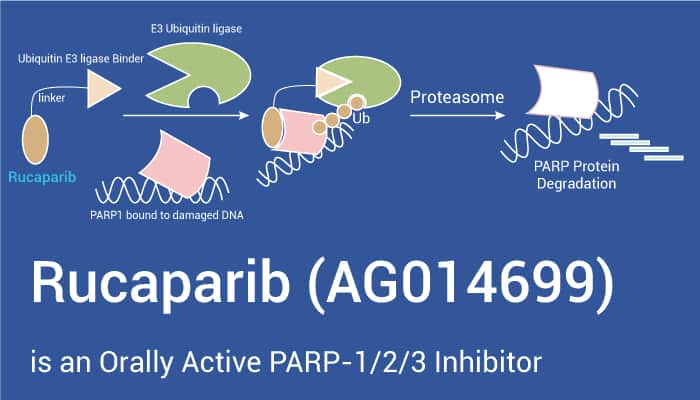Poly (ADP-ribose) polymerase (PARP), a family of proteins, is involved in various cellular processes such as DNA repair and programmed cell death. PARP presents in the cell nucleus. It consists of a DNA-binding domain, a caspase-cleaved domain, an auto-modification domain, and a catalytic domain. In particular, the protein can detect and initiate an immediate cellular response to metabolic, chemical, or radiation-induced single-strand DNA breaks (SSB). Once PARP detects SSB, it will bind to the DNA, and begins to synthesize a signal for DNA-repairing enzymes. PARP plays an important role in cell proliferation, thus, PARP inhibitors have been used for researching anticancer.
Rucaparib (AG014699) is an orally active PARP (PARP-1, -2, and -3) small molecule inhibitor with IC50s <5 nM. Indeed, it can inhibit PARP enzymes, which play a key role in DNA repair, to form toxic PARP-DNA complexes in cells, resulting in DNA damage, ultimately leading to cell death.
 Rucaparib shows excellent anticancer activity against various tumor cells, including breast, ovarian, and prostate cancer cells.
Rucaparib shows excellent anticancer activity against various tumor cells, including breast, ovarian, and prostate cancer cells.
Rucaparib inhibits MDA-MB-468, MDA-MB-231, and Cal-51 with IC50s of 9.7 μM, 13 μM, and 8.6 μM. This agent (0-10 μM) induces γ-H2AX formation and PARP cleavage in a dose-dependent manner indicative of DNA damage and apoptosis in these cancer cell lines. Besides, it also decreases the phosphorylation levels of Stat3 and dose-dependently increases the phosphorylation levels of Akt.
In addition, in Capan-1 tumor-bearing mice, Rucaparib (10 mg/kg; IP, daily for 5 days per week, for 6 weeks) significantly inhibits the growth of the tumor. Even though it is cleared from the plasma, Rucaparib is also retained in tumor xenografts. Moreover, the inhibition of PARP activity in tumor xenografts continues for 1 week after a single injection.
In conclusion, Rucaparib is a potent and orally active PARP inhibitor, possessing anticancer activity.
References:
[1] Syed YY. Drugs. 2017 Apr;77(5):585-592.
[2] Murray J, et al. Br J Cancer. 2014 Apr 15;110(8):1977-84.
[3] Chuang HC, et al. Breast Cancer Res Treat. 2012 Jul;134(2):649-59.